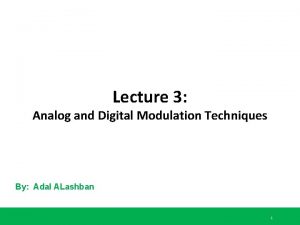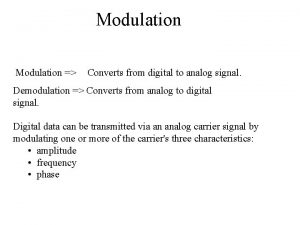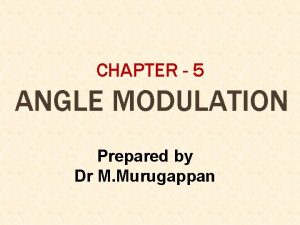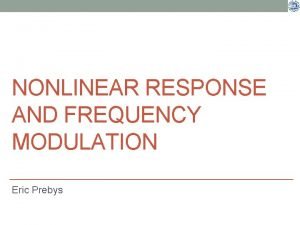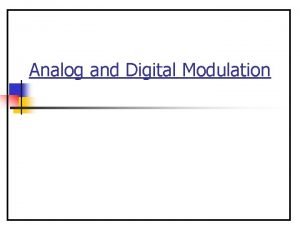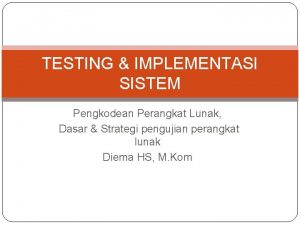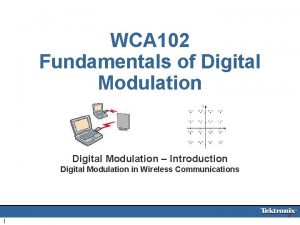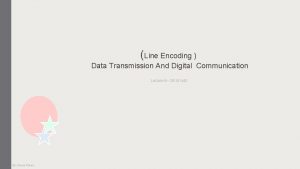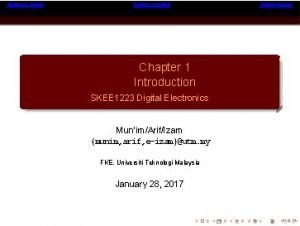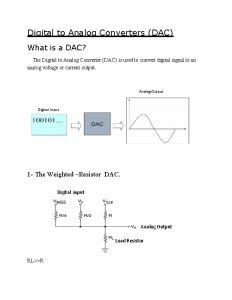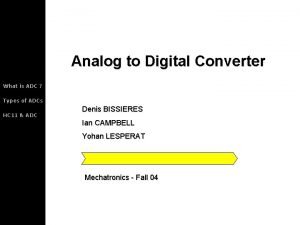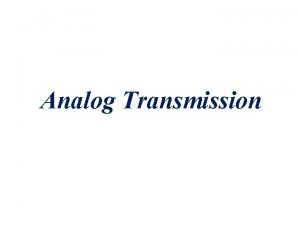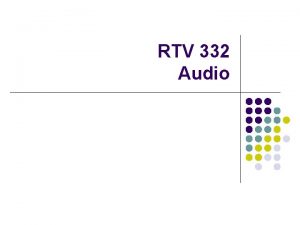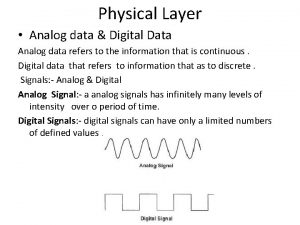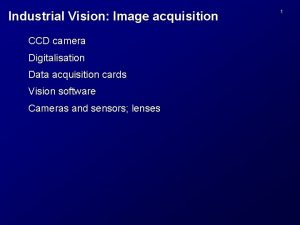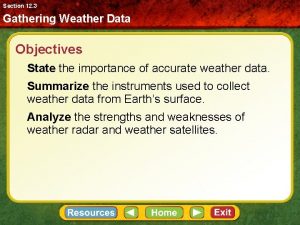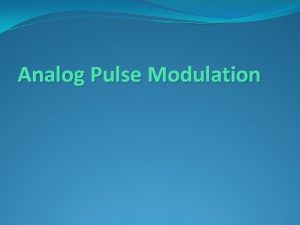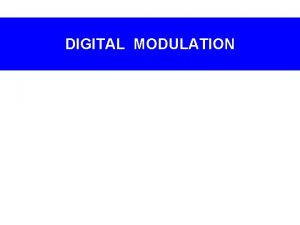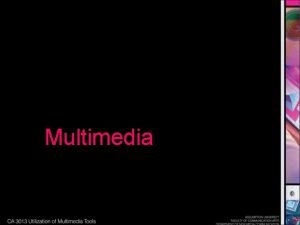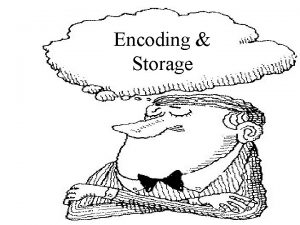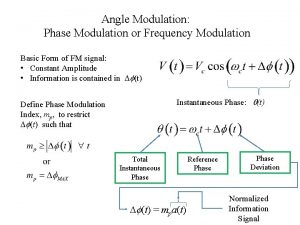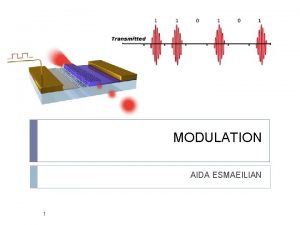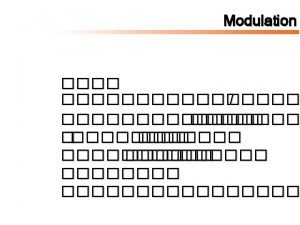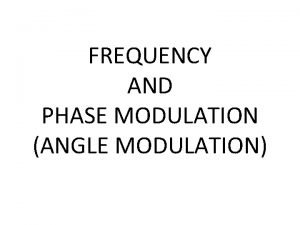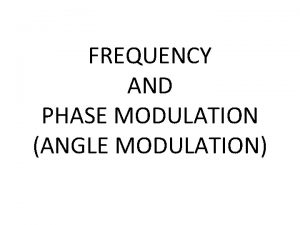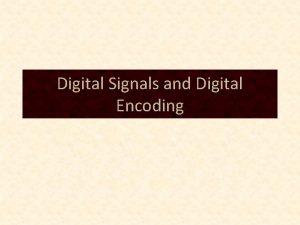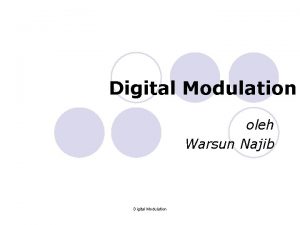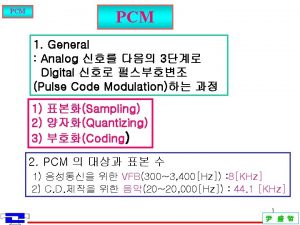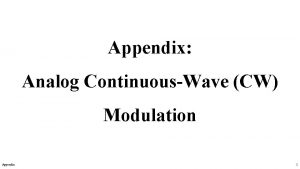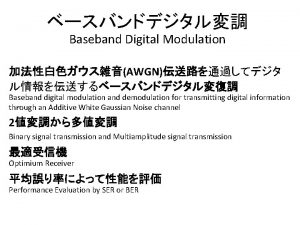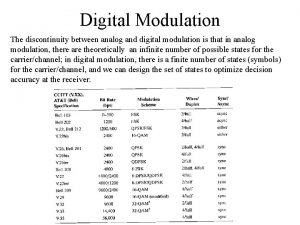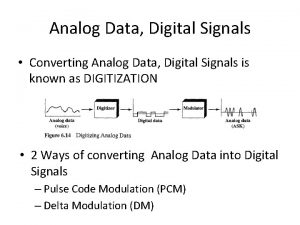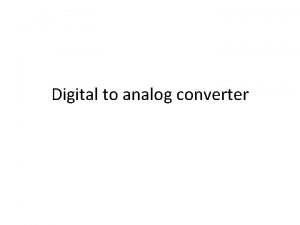Digital to Analog Encoding 1 2 Digital modulation

























- Slides: 25

Digital to Analog Encoding 1

2

Digital modulation techniques Amplitude Shift Keying n Frequency Shift Keying n Phase Shift Keying n Quadrature Amplitude Modulation (QAM) n 3

Amplitude Shift Keying n ASK – The strength of carrier signal varies (the amplitude changes) – The frequency and phase remain constant – The speed of transmission is limited by the physical characteristics of the transmission media – Susceptible to noise interference n (noise = unintentional voltages introduced onto a line by other sources, heat, etc. ) 4

Amplitude Shift Keying (ASK) 5

Bandwidth for ASK Carrier frequency 6

Frequency Shift Keying The frequency of the carrier varies n Amplitude and phase remain constant n 7

FSK 8

FSK n FSK spectrum is the combination of 2 ASK spectra centered around fc 0 and fc 1 • Bandwidth = the baud rate + the frequency shift • ( OR the difference between the two carrier frequencies) 9

Bandwidth for FSK Bandwidth = the baud rate + the frequency shift ( OR the difference between the two carrier frequencies) 10

Phase Shift Keying The phase of the carrier varied n The amplitude and frequency remain constant n 11

PSK Constellation OR phase-state diagram 12

PSK Example : if a phase 0 degree represents binary 0 change the phase to 180 degree binary 1 13

4 -PSK or QPSK n n n It is not susceptible to noise degradation Smaller variations in the signal can be detected reliably by the receiver Thus, instead of utilizing only two variations of signal (each represent one bit), four variations can be used – Each phase shift represents two bits n n A phase of 0 00 A phase of 90 degrees 01 A phase of 180 degrees 10 A phase of 270 degree 11 14

4 -PSK 15

4 -PSK Characteristics 16

8 -PSK Characteristics The previous idea is extended to 8 -PSK 17

PSK Bandwidth Minimum BW required is the same as ASK 18

4 -QAM and 8 -QAM Constellations 19

8 -QAM Signal 20

Aspects of Digital-to. Analog Conversion n Basic Issues – Bit rate – Baud rate – Carrier Signal 21

Bit Rate and Baud Rate n n Bit rate = number of bits transmitted during one second Baud rate = number of signal units per second that are required to represent those bits – Determines the bandwidth required to send the signal – It is less than or equal to the bit rate n (In transportation : – A baud is analogous to a car – A bit is analogous to a passenger 22

Carrier Signal n In analog transmission – The sending device produces a high-frequency signal that acts as a basis for the information signal – It is called carrier signal or carrier frequency – The receiving device is tuned to the frequency of the carrier signal that it expects from the sender – Digital information is modulated on the carrier signal by modifying (amplitude, frequency, phase) shift keying 23

Bit Rate and Baud Rate 24

Bit Rate and Baud Rate 25
 Disadvantages of fsk
Disadvantages of fsk Modulation digital to analog
Modulation digital to analog Digital to analog encoding
Digital to analog encoding Advantages of angle modulation over amplitude modulation
Advantages of angle modulation over amplitude modulation Amplitude modulation vs frequency modulation
Amplitude modulation vs frequency modulation Wave modulation
Wave modulation Data encoding and modulation
Data encoding and modulation Auto coding software
Auto coding software Thermal noise in analog communication
Thermal noise in analog communication Data encoding techniques in computer networks
Data encoding techniques in computer networks Advantages of digital modulation
Advantages of digital modulation Disadvantages of digital modulation
Disadvantages of digital modulation Line coding in data communication
Line coding in data communication Introduction to analog and digital electronics
Introduction to analog and digital electronics Digital to analog converter
Digital to analog converter Whats an adc
Whats an adc Impulse invariant method formula
Impulse invariant method formula Digital to analog conversion in data communication
Digital to analog conversion in data communication Digital vs analog sound
Digital vs analog sound Analog and digital video
Analog and digital video Analog signla
Analog signla Analogue and digital transmission in computer networks
Analogue and digital transmission in computer networks Analog image and digital image
Analog image and digital image Single slope adc
Single slope adc Digital image acquisition for analog sem
Digital image acquisition for analog sem Compare and contrast analog and digital forecasting
Compare and contrast analog and digital forecasting
